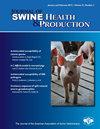在一个稳定的小型群居系统中母猪的行为和生产力
IF 0.7
4区 农林科学
Q3 Agricultural and Biological Sciences
引用次数: 5
摘要
目的:量化在连续两个妊娠期内使用单一进出口电子母猪饲养器(ESF)喂养时,分组为静态小组的雌性的行为和生产力。材料和方法:在妊娠第35天,58只没有集体妊娠住房经验的母猪被纳入3个静态连续队列(队列1,n=20;队列2,n=18;队列3,n=20)。在整个产仔期,猪被单独饲养,健康的猪被移回各自的组中进行第二次妊娠(队列1,n=19;队列2,n=13;队列3,n=17)。对每个妊娠期的猪行为、社会等级和妊娠后生产力进行量化。结果:在第一次妊娠和第二次妊娠之间,激动行为减少(P<.001)。与中、低等级母猪相比,高等级母猪在ESF周围引发了更多的激动发作(P<0.001)。活动(P=.78)和非活动(P=0.76)行为的持续时间在妊娠期之间没有差异,但与围栏的其他区域相比,在ESF附近观察到了更积极的行为(P<.001)。与中级和低级母猪相比,高级母猪更频繁地造访饲养场(P<0.001)。根据母猪排名,在随后的产仔数或雌性生产力指标上没有发现差异。意义:在第一次和第二次分娩之间,将怀孕的雌性动物安置在带有ESF的静态小群体中,可以减少攻击性,而不会对猪的一般行为或生产力产生不利影响。本文章由计算机程序翻译,如有差异,请以英文原文为准。
Sow behavior and productivity in a small stable group-housing system
Objectives: To quantify behavior and productivity of females grouped in small static groups when fed using a single-entry/exit electronic sow feeder (ESF) over two consecutive gestation periods. Materials and methods: Fifty-eight gilts with no previous experience in group gestation housing were enrolled into 3, static, successive cohorts (Cohort 1, n = 20; Cohort 2, n = 18; and Cohort 3, n = 20) at day 35 of gestation. Pigs were housed individually throughout the farrowing period, and pigs that were healthy were moved back into their respective groups for their second gestation (Cohort 1, n = 19; Cohort 2, n = 13; Cohort 3, n = 17). Pig behavior, social rank, and post-gestation productivity was quantified for each gestation period. Results: Agonistic behaviors decreased between the first and second gestation (P < .001). High-ranked sows initiated more agonistic bouts around the ESF when compared to intermediate- and low-ranked sows (P < .001). Duration of active (P = .78) and inactive (P = .76) behaviors did not differ between gestation periods, but more active behaviors were observed near the ESF when compared to other areas of the pen (P < .001). High-ranked sows visited the feeder more frequently when compared to intermediate- and low-ranked sows (P < .001). No differences in subsequent litter or female productivity measures were found based on sow ranking. Implications: Housing gestating females in small static groups with an ESF decreased aggression between the first and second parity without detrimentally affecting general pig behavior or productivity.
求助全文
通过发布文献求助,成功后即可免费获取论文全文。
去求助
来源期刊
CiteScore
1.80
自引率
0.00%
发文量
29
审稿时长
>36 weeks
期刊介绍:
The Journal of Swine Health & Production (JSHAP) is an open-access and peer-reviewed journal published by the American Association of Swine Veterinarians (AASV) since 1993. The aim of the journal is the timely publication of peer-reviewed papers with a scope that encompasses the many domains of applied swine health and production, including the diagnosis, treatment, management, prevention and eradication of swine diseases, welfare & behavior, nutrition, public health, epidemiology, food safety, biosecurity, pharmaceuticals, antimicrobial use and resistance, reproduction, growth, systems flow, economics, and facility design. The journal provides a platform for researchers, veterinary practitioners, academics, and students to share their work with an international audience. The journal publishes information that contains an applied and practical focus and presents scientific information that is accessible to the busy veterinary practitioner as well as to the research and academic community. Hence, manuscripts with an applied focus are considered for publication, and the journal publishes original research, brief communications, case reports/series, literature reviews, commentaries, diagnostic notes, production tools, and practice tips. All manuscripts submitted to the Journal of Swine Health & Production are peer-reviewed.

 求助内容:
求助内容: 应助结果提醒方式:
应助结果提醒方式:


